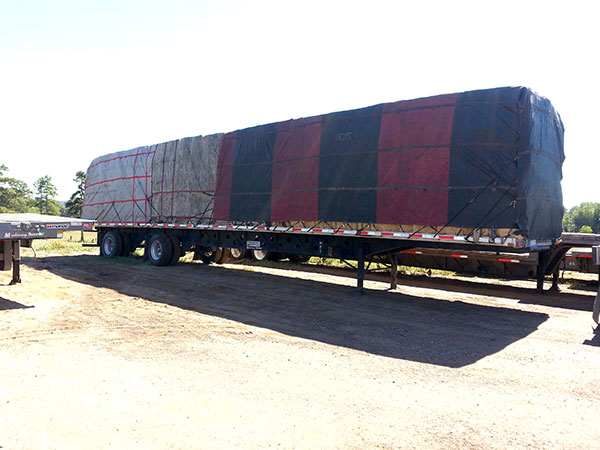Tarping is both an art and an ordeal.
Since it's required for much of the freight hauled by a flatbed, most experienced drivers refine their own creative tarping techniques to get the job done as efficiently as possible. Still tarping is, and always has been, an arduous and even dangerous job that most drivers—and their managers—learn to dread. The challenge of tarping is, in fact, why experienced flatbed drivers typically command higher pay than their colleagues in pulling dry-vans where the process isn't required. They earn it.
Not much has changed about tarping since the dawn of commercial trucking. More often than not, it's a DIY chore your driver does the same way his grandfather did it. Here in the 21st century, however, better options now exist. Since little can be done to make tarping really efficient, the trailer itself has evolved to eliminate or at least substantially minimize the need for it. Roland curtainside trailers offer the best of both the flatbed and van worlds: three-side flatbed-style access for unobstructed loading and unloading, as well as a hard shell roof and durable curtains that enclose the load for shelter from the elements and security, just like a van. While Federal laws still require securing certain loads inside with straps where necessary, curtainside trailers can make external tarping almost extinct.
Here are three good reasons why you should stop tarping ASAP:
Safety First
A flatbed tarp generally weighs somewhere between 60 to 100 pounds, depending on the tarp size. Getting it in place is an awkward combination of lifting, throwing, and pulling—basically, ground zero for back injuries. Climbing up atop the load is frequently necessary in tarping, a precarious act in wet or icy weather. Slips and falls are a constant threat. Caught by a random gust of wind, an unfurled tarp can yank a 200-pound driver off a flatbed deck to certain injury. When these and other tarp-related accidents occur, they are often a source of insurance claims, workmen's compensation cases and may take a good driver off the road indefinitely.
Lost Time
Whenever tarping is necessary at a pickup, freight managers know that at least one extra hour will be consumed fitting the tarp before the truck moves anywhere. That's an hour that your driver isn't driving and the load isn't getting from Point A to Point B. Little can be done to make the old-school process of tarping much faster. Since no two loads are exactly alike, the procedure must often be slightly customized to meet that individual circumstance, defeating “textbook” approaches to standardize the procedure into assembly-line consistency. Tarping takes as long as it takes. Period.
Security Matters
A tarped load is secured but not really enclosed as it would be inside a curtainside or van trailer. Exposure to outdoor moisture, dust, and pollutants may be an issue with certain cargo, even under a tarp. A tarp is a partial cover, not a container that fully conceals “sensitive” loads that should not be glimpsed by unauthorized persons. Also, high-value or particularly fragile freight may not be appropriate for the weight and stress of a tightly-cinched tarp and are more safely sheltered inside a curtainside and secured with straps.
Want to learn more about or request more info on how a curtainside trailer can help you? Then please feel free to make your request here and someone will be back with you shortly.




